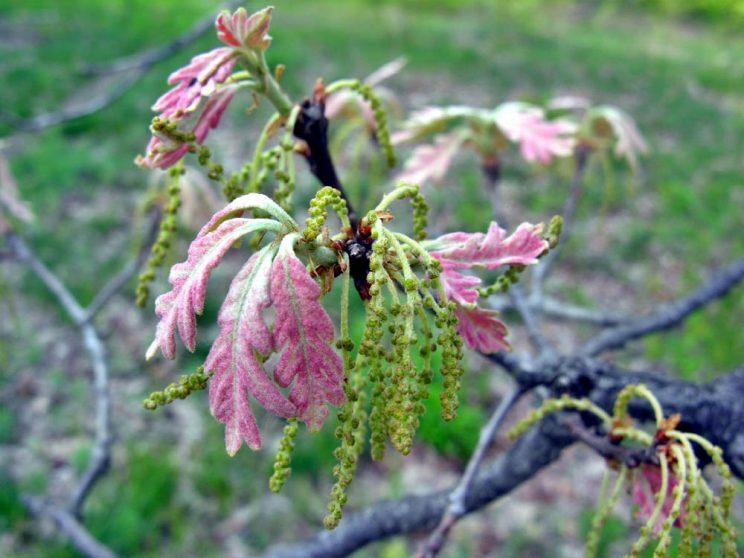by Mary Patterson
Your senses of touch and smell can both help you identify some interesting plants in High Park (but be careful not to touch toxic plants such as poison ivy!)
Scouring Rush
A plant with silica crystals (sand) in its leaves making it shed water? Yes, and you can find it growing where water trickles down the steep hillsides that run up from Spring Rd. It’s known as Scouring Rush or Horse Tails (Equisetum hyemale) and is designated as a menace in Australia, very invasive in the U.S. and a joy to modern flower arrangers here in Canada. Its hollow ¼” wide stems feel dry and flinty, and are distinctively ribbed lengthwise like fluted straws. They have no leaves and are evergreen. Early settlers used bundles of them to make scrubbers to clean their pots and pans. The roots are rhizomes that spread over a metre in depth and run widely underground, springing up with new plants as much as 150 metres away from the mother plant, hence its invasive status.
Skunk Cabbage
And if you’re walking along Spring Rd. searching for the Scouring Rush, look in early spring for Skunk Cabbage (Symplocarpus foetidus) in the dampest surrounding areas. Or perhaps, just sniff, because if you blunder and step on one, bruising it, you’ll know why it gets its name! The strange flower is like a rolled cone, some 6” tall, mottled wine/green/brown, and thrusts out of the wet soil very early in spring, sometimes even melting the late snow that surrounds them, as it is one of the few plants capable of heating up the surrounding soil. In later spring, the green cabbage-like leaves appear, also carrying the skunk-like scent. [Editor’s note: This plant does not currently occur in High Park but once did and perhaps may again with future restoration. It can be found nearby in the Humber valley.]
Garlic Mustard
Another spring odour comes from the Garlic Mustard (Alliaria petiolata) plants that now engulf parts of the woodland slopes, where it thrives in the moist soil choking out many native wildflowers such as trilliums and bloodroot. You’ll sniff its strong garlic aroma when you step on the rounded leaves. Look for it in the woods around the “Dream” theatre site, where its small white flowers appear in June, each producing enough seed to form up to 800 plants.
Wild Bergamot and Other Mints
Your sense of touch and smell will both serve to find you two common examples of the mint family, all of which have square stems and sweetly pungent scent. In the sandy, stony, low organic soils in the open meadows south of the ball diamonds, clumps of mauve-flowered Wild Bergamot (Monarda fistulosa) thrive. Its cousin, wild mint (Mentha spp), can be located in moister, shadier locations throughout the park. Both of these plants have been used medicinally, bergamot most commonly as a tea-type drink, while the use of mint is universal, both externally in skin lotions, cold remedies and for soothing various stomach disorders.
Stinging Nettle
A somewhat invasive plant is Stinging Nettle (Urtica dioica is an introduced species while U. gracilis is native). It is treasured in some parts of the world for use as a medicine, or as a soup ingredient, and even in dyeing cloth. Some people cultivate them now as a food source. It is also an important host plant for several species of native butterflies, such as Red Admiral. But beware its bite! The hollow hairs on the underside of the leaves and on the stems need only the slightest touch to make them break off and give you an injection of formic acid, which causes a burning rash and small bumps on your skin. Some experts swear by rubbing the afflicted area with curly dock which often grows in the same areas as the nettles, or try using the leaves of borage which, when rubbed over the afflicted area, will almost immediately stop the burning. (Borage is commonly found along the edges of garden areas in High Park with its bright blue flowers in early summer springing up from amidst its large pointed hairy leaves.)
Common Mullein
Even rubbing your skin with velvety mullein leaves will help out when you’ve been attacked by stinging nettles. Common Mullein (Verbascum thapsus) is easy to find in sunny open field areas. Its familiar whorls of large leaves, which hug the ground, are surmounted by a tall spike of yellow bloom which can reach 5 or 6 ft. in height in mid to late summer. It’s a true biennial plant, blooming in its second year of growth. Its leaves are another one of the “feel me” type as they are so thickly covered with fine hairs that they appear silver amongst other green plants.
























